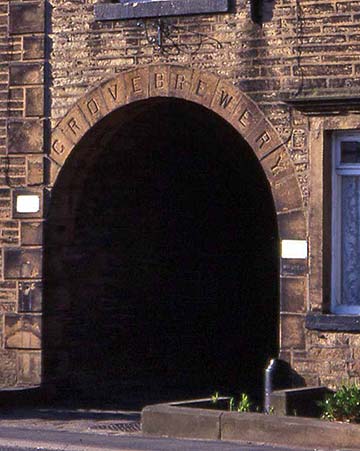Local History Society Report
Breweries and licensed trade in the Upper Calder Valley from 1800
Speaker:Peter Robinson
Friday, 21 December 2018
Peter Robinson returned to Hebden Bridge Local History Society to tell the story of the inns and beerhouses of the area during the period of industrialisation and population growth after 1800. The development of steam power meant that the factories and workforce were concentrated in the valley bottoms instead of the hill tops and demand for new drinking places also grew. Government had long kept a hold on the sale of spirits and ale through licensing laws and in 1830 responded to demand, and to alarm about a proliferation of gin shops, with a new kind of licence to sell only beer. The Beerhouse Act of 1830 changed the way people consumed alcohol and the places where they drank. After this time the number of beerhouses grew faster than the alehouses which had a licence to sell a full range of alcohol.

Locally, Peter has found that houses were converted for the sale of beer, as farm houses such as Upper Hanroyd Farm in Midgley, set aside one of the downstairs rooms for the purpose. Other such conversions are found throughout the area, including some like the White Horse at Friendly which was operating as a licensed beerhouse in 1840 and is still a public house. Most of these places brewed their own beer, but soon demand was such that purpose built pubs became more common, often owned by breweries which supplied numerous houses.
The concerns of the anti-drink lobby were far from abated, and by 1869 the granting of licences was tightened up so that the beerhouses could be made more respectable – the licensee had to be of good character, and keep good order. Peter's researches have revealed plenty of examples where this was far from the case, especially when the beerhouse was in a remote place, like the Travellers' Rest at Widdop. When the reservoirs were being built its clientele of construction workers were considered far from respectable. In such isolated places they might be playing banned games like pitch and toss and licensees brought to court had to protect their reputation by pleading that they were at the mercy of a 'rougher element.' In an account of an affray at theTravellers' Rest the publican claimed he was threatened by his customers who couldn't be persuaded to leave at closing time and trashed the place. The evidence was confused however, and it is just as likely that the publican happily colluded with a profitable 'lock in.'
The tradition of each alehouse owner being a maltster who brewed their own beer declined in the second half of the century with the establishment of 'Licensed Common Brewers' who could supply the widely dispersed new beerhouses. They would have a network of agents and with improved transport links get their product to the new customers. The brewers took more control by purchasing properties and by vetting licensees so that many of the pubs became tied houses. One of the most successful breweries was the Grove Brewery at Brearley, which had an empire of pubs in Hebden Bridge, Todmorden and Mytholmroyd. By 1899 the premises at Brearley was extended with a malt kiln, stables and reservoir, and they even began to brew temperance drinks.
The clash between proponents of temperance and the licensed trade did not abate and in the early 20th century there was a move to make pubs more respectable and appealing to a wider and more diverse clientele, including women. It is from this period that some of the larger more impressive public houses date. The breweries, which had over time consolidated their numbers and extended their power, commissioned notable architects to design public houses that had an air of confidence and grandeur. They included large function rooms and improved facilities and favoured classical neo-Georgian or Mock Tudor architectural styles.
The twentieth century saw public houses change in nature, culminating in the relaxing of licensing laws during the 1980s and 90s, but as Peter noted, the 21st century has seen a continuing decline in the licensed trade. The reasons for this are many and largely reflect changes in culture such as supermarkets selling alcohol for home consumption. Many public houses have closed during the last twenty years, some of the old ones reverting to private houses - just as in earlier times owners had seized an opportunity to sell alcohol from their front rooms. The recent phenomenon of micro-breweries suggest that the story hasn't yet come to an end.
The next meeting of Hebden Bridge Local History Society will feature Kate Lycett talking about the inspiration and research behind her highly successful art project looking at Lost Houses of the South Pennines. Wednesday 9th January at Hebden Bridge Methodist Church at 7. 30. Everyone welcome.
With thanks to Sheila Graham for this report
Details of all the Society’s activities can be found on the website and you can also follow them on their Facebook page.
See also
The first few episodes of Gentleman Jack (screenplay: Sally Wainwright) were inspired by two books written by local historian Jill Liddington, including Nature's Domain published by Pennine Pens


